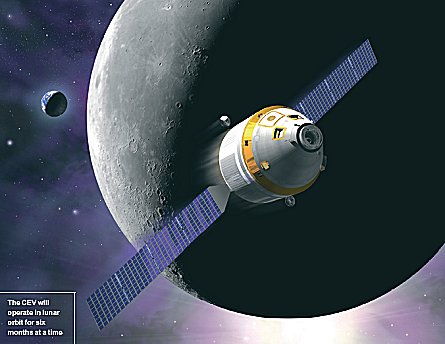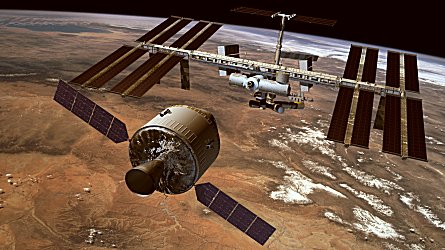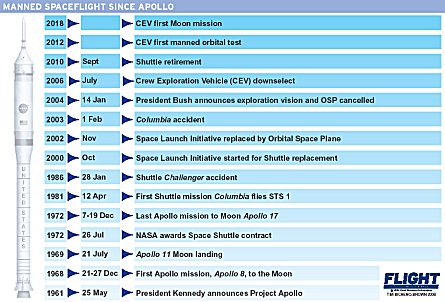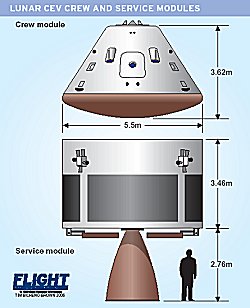The next few years will be make-or-break for NASA’s Vision for Space Exploration (VSE), Howard McCurdy, professor of public affairs at the American University in Washington DC, believes. An expert on the agency, McCurdy says advocates of VSE “have only a few years to establish this programme before it becomes vulnerable to death by transition”.
McCurdy is under no illusions as to how long NASA has to prove that President George Bush’s vision of returning the USA to the Moon is not a step too far. The Space Shuttle programme, costing $5 billion a year, will end in 2010, to be replaced by the VSE and its spacecraft.
 NASA’s future manned spacecraft is to be the Crew Exploration Vehicle (CEV). This consists of an Apollo-like capsule and service module with a launcher that uses Shuttle technology. The US space agency intends to use its existing facilities and contractors to develop, test and launch the CEV. McCurdy is in no doubt that making the transition from one multi-billion dollar programme to another could be as big a challenge for NASA as development of the CEV itself.
NASA’s future manned spacecraft is to be the Crew Exploration Vehicle (CEV). This consists of an Apollo-like capsule and service module with a launcher that uses Shuttle technology. The US space agency intends to use its existing facilities and contractors to develop, test and launch the CEV. McCurdy is in no doubt that making the transition from one multi-billion dollar programme to another could be as big a challenge for NASA as development of the CEV itself.
Resource transfer
To manage this process, NASA has created the High Level Transition Control Board, which had its first meeting last October. The board will help decide how and when to transfer resources from the Shuttle Transportation System – the orbiter, its external tank (ET) and solid rocket boosters (SRB) – to the Exploration Transportation System (ETS) with the CEV, its launch vehicle and the 125t-to-low-Earth-orbit heavylifter needed to reach the Moon.
Chaired by William Gerstenmaier and Scott Horowitz, respectively the associate administrators for NASA’s space operations and exploration systems mission directorates, the board will operate for many years as first Shuttle and then International Space Station (ISS) resources are transferred to exploration.
Some transfer decisions will be taken at the programme level. As the Shuttle programme concludes, it will no longer need certain components or capabilities. NASA’s Constellation programme, to develop the infrastructure for human and robotic exploration of the Moon, Mars and beyond and charged with the CEV’s development, can request a transfer. Where neither Shuttle nor Constellation require a capability, it will be offered to the rest of the agency. If there is no interest, the board will decide what to do with the assets and contracts.
The board has catalogued and analysed the vendors that will be affected by this process. Already lower-level contractors for ET umbilical disconnects are seeing their work end because the Shuttle programme has all it needs for the remaining 19 flights. For similar reasons, the contract for aluminium lithium supply, used for ET construction, is being transferred to Constellation.
Another issue to be dealt with is the supply of casings for the SRBs. NASA now has enough of them, not only for the Shuttle flights, but for several ISS CEV missions as well.

A modified SRB (Constellation is analysing future casing design) will be the first stage of the Crew Launch Vehicle (CLV). Its second stage uses a new expendable version of Rocketdyne’s Space Shuttle main engine (SSME), designated the RS-25E. NASA plans to place the contract for development of the CLV’s first stage in May next year, before it selects a prime contractor for the CEV in August.
The board has been carrying out an audit of NASA’s centres’ abilities to meet ETS needs, and in the next few months it expects to have to take decisions about NASA’s Michoud ET assembly facility.

“We’re doing a survey of what we need for testing,” says Michael Hecker, director of the Constellation systems division within NASA’s exploration systems mission directorate, and a co-ordinator on the board. NASA is trying to determine what it needs now and what it could use later, what it can refurbish and what will have to be built from new, he explains.
Of the agency’s 10 centres, those in the vanguard of change are Marshall Space Flight Center in Huntsville, Alabama, which oversees space transport system development; Stennis Space Center in Mississippi, responsible for liquid engine propulsion; Ames Research Center in California, which manages heat shields; and Johnson Space Center in Houston, Texas, which handles the CEV’s capsule.
Kennedy Space Center in Florida, launch site for the Shuttle, will be the location for the CLV test flights. It is likely that Shuttle launch pad 39A will be modified for the CLV from 2008, while the Shuttle will continue to use pad 39B until 2010. Hecker is confident the transition at Kennedy can be managed successfully. “So far we have a pretty good plan to use CEV and Shuttle resources,” he says.
Another early conclusion is that Stennis is in a good position to work on the CLV’s second-stage engine, as it has been improving the SSME throughout the Shuttle’s life. But upgrading a mated-stack vibration test facility at Marshall will require millions of dollars of investment and, even once it is refurbished, it will not be tall enough to test the 125t heavylift vehicle.
Changes required at other NASA locations could include reactivation of the rocket engine altitude-test chamber at Ohio’s Glenn Research Center, and the possible use of the US Air Force’s Tullahoma, Tennessee windtunnels instead of NASA facilities at Ames and Langley.
Beyond reactivation, new facilities are going to be needed – in particular for testing the launch escape system (LES), a solid-rocket tower atop the CEV that will pull the capsule away from a malfunctioning CLV on the launch pad or during the ascent up to the point of first-stage separation. Trade studies are under way to determine how best to test the LES, but it will involve something like the Little Joe rocket used to test the Apollo launch abort system.
NASA is also looking at where it need not build physical hardware and instead use computers. One option being considered is the use of a simulated mission control for astronaut training.
CEV bidders
Wherever NASA chooses to base the launch-abort test and simulated mission-control sites, the centre audit has been fed into the CEV Phase 2 solicitation, issued last week. Under Phase 1, requirements for the CEV were provided in March 2005 to two consortia led by Lockheed Martin and Northrop Grumman/Boeing, and in July the bidders were each awarded $28 million to provide detailed designs. Phase 2 will include changes to NASA’s requirements resulting from the 60-day Exploration Architecture Systems Study (ESAS) begun in April. Originally, the bidders were asked to define the mission architecture and launch vehicles, but ESAS selected an Apollo-like mission profile for returning to the Moon and decided the overall CEV and launch vehicle designs.
The CEV configuration is essentially the same as for the Apollo missions, but the 5.5m (18ft)-diameter crew module is three times larger than the original command capsule, with room for up to six astronauts and more volume per occupant. Six astronauts could be carried on a flight to the ISS, and four on a longer lunar mission. The service module will use solar arrays to power electrical systems.

In low-Earth orbit, the CEV will dock with an Earth departure stage and lunar surface module – launched separately on the heavylifter – for the journey to the Moon. Once in orbit around the Moon, all four crew will descend to the surface at a southern polar base, where eventually they will stay for up to six months at a time, leaving the service module to operate autonomously in orbit for extended periods. On return, the crew capsule with re-enter the Earth’s atmosphere and, in another departure from Apollo, parachute to a landing on solid ground.
ISS missions
 NASA’s architecture calls for the CEV to be used for crew and cargo flights to the ISS, as well as Moon missions. “We are sizing the CEV to meet the lunar mission. In ISS crew transfer and pressurised cargo mode, the service module will look the same. For unpressurised cargo missions, we will use a more austere version,” says Leonard Nicholson, deputy CEV programme manager for the Northrop consortium and former Boeing ISS deputy programme manager. “We’re planning to build three to five shipsets a year for a mix of crew and cargo missions. The priority is on ISS at the front end and lunar at the back end.”
NASA’s architecture calls for the CEV to be used for crew and cargo flights to the ISS, as well as Moon missions. “We are sizing the CEV to meet the lunar mission. In ISS crew transfer and pressurised cargo mode, the service module will look the same. For unpressurised cargo missions, we will use a more austere version,” says Leonard Nicholson, deputy CEV programme manager for the Northrop consortium and former Boeing ISS deputy programme manager. “We’re planning to build three to five shipsets a year for a mix of crew and cargo missions. The priority is on ISS at the front end and lunar at the back end.”
NASA’s ESAS-related decision to bring critical technologies in-house will have an impact on the consortia. The space agency will now provide the crew, the service module’s liquid oxygen/methane engine, igniters, docking system, heat shield and parachute system. But despite NASA’s new focus on specific technologies, the bidders’ job is still to conduct trade studies for most of the vehicle’s systems. These trades, the centres’ audit and ESAS changes will be used by the consortia to assess modifications needed at their own facilities, which have been tied to the Shuttle programme for the past 30 years.
NASA’s Michoud facility, operated by Lockheed, is sized to produce six ETs a year. The company is in negotiation with NASA about how and when it manufactures the tanks for remaining flights, with the last ET to be completed in 2009 A heavily modified version of the ET would be used for the 125t-payload heavylift launcher, but its development does not start until after 2010. Because of this gap, NASA has been considering using Michoud as the location for CLV upper-stage work to ensure continuity of the workforce.
But Lockheed hopes to use Michoud for CEV structures. “We could build the structure of the CEV there and use the engineering resources,” says vice-president for space exploration John Karas. “We’re looking at how best to do it, considering transition costs and termination costs for vendors and people.” Michoud is not the company’s only Shuttle-related facility, and Karas is “looking long and hard” at Lockheed’s Houston, Texas and Cape Canaveral, Florida facilities for capabilities related to the ETS.
Location assessment
Meanwhile, Northrop is going through a similar location assessment process, looking at its team’s Shuttle facilities in Alabama, Florida and Texas to see where there is overlap with CEV needs. Northrop’s main partner is Boeing, integrator of the Shuttle stack – orbiter, ET and SRBs and US ISS module manager.
As a result, the Northrop consortium has access to a range of testing and development facilities. “We don’t see the need to build a whole lot of new facilities,” says Nicholson.
NASA’s plan calls for CEV tests to begin in 2008, leading to manned orbital flights by 2012. Delivering by those dates will be important whoever wins, simply to retain the political support for exploration vision. The VSE programme’s predecessor, NASA’s Space Launch Initiative, and its short-lived successor, the Orbital Space Plane, suffered from budget and schedule problems and NASA and its contractors know they must heed McCurdy’s warning. As one NASA source says: “The agency is looking to fire the engines for the CEV launch vehicle in 2008 to show, for political reasons, that real progress is being made.”
ROB COPPINGER / LONDON
Source: Flight International
















